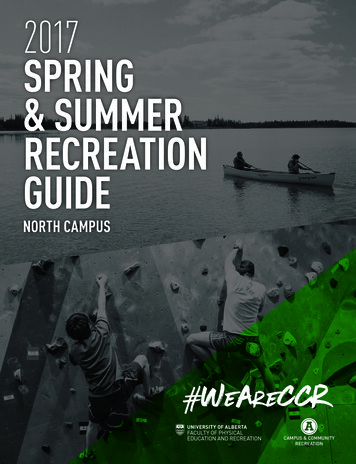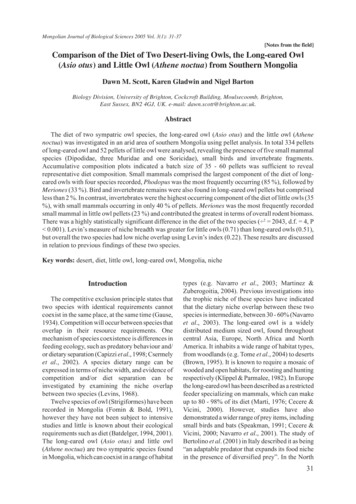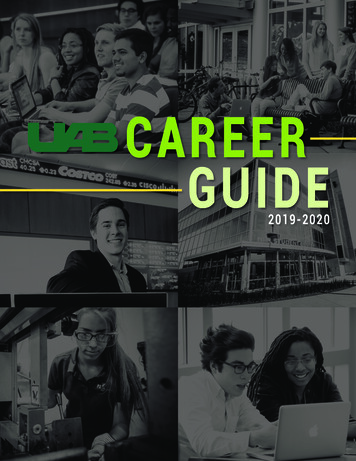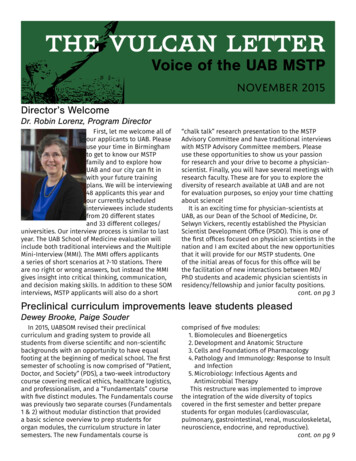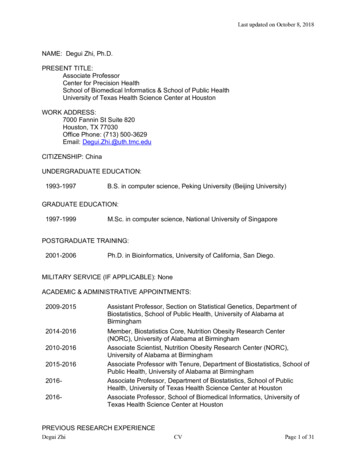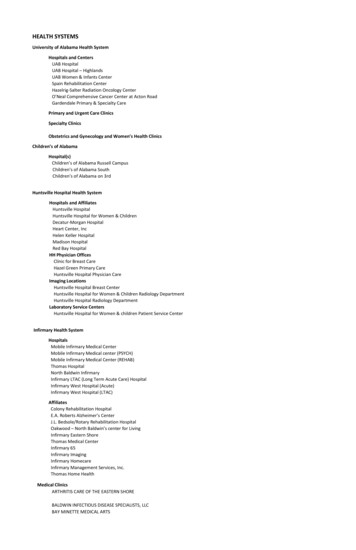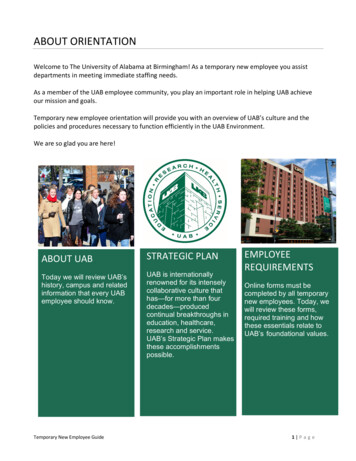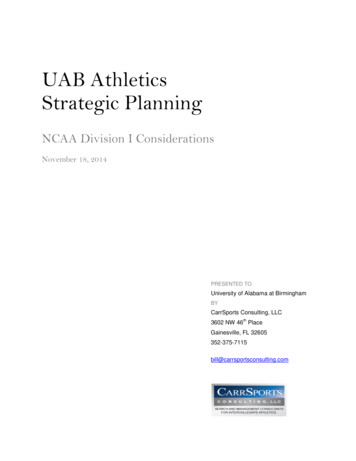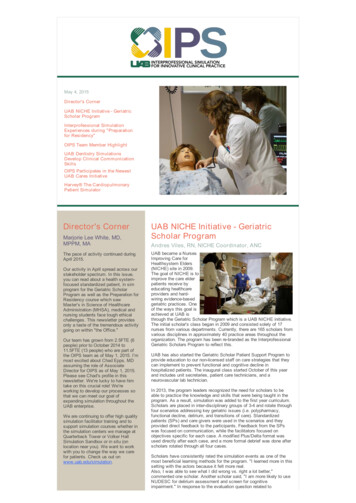
Transcription
May 4, 2015Director's CornerUAB NICHE Initiative - GeriatricScholar ProgramInterprofessional SimulationExperiences during "Preparationfor Residency"OIPS Team Member HighlightUAB Dentistry SimulationsDevelop Clinical CommunicationSkillsOIPS Participates in the NewestUAB Cares InitiativeHarvey The CardiopulmonaryPatient SimulatorDirector's CornerMarjorie Lee White, MD,MPPM, MAThe pace of activity continued duringApril 2015.Our activity in April spread across ourstakeholder spectrum. In this issue,you can read about a health systemfocused standardized patient, in simprogram for the Geriatric ScholarProgram as well as the Preparation forResidency course which sawMaster's in Science of HealthcareAdministration (MHSA), medical andnursing students face tough ethicalchallenges. This newsletter providesonly a taste of the tremendous activitygoing on within "the Office."Our team has grown from 2.5FTE (6people) prior to October 2014 to11.5FTE (13 people) who are part ofthe OIPS team as of May 1, 2015. I'mmost excited about Chad Epps, MDassuming the role of AssociateDirector for OIPS as of May 1, 2015.Please see Chad's profile in thisnewsletter. We're lucky to have himtake on this crucial role! We'reworking to develop our processes sothat we can meet our goal ofexpanding simulation throughout theUAB enterprise.We are continuing to offer high qualitysimulation facilitator training and tosupport simulation courses whether inthe simulation centers we manage atQuarterback Tower or Volker HallSimulation Sandbox or in situ (onlocation near you). We want to workwith you to change the way we carefor patients. Check us out onwww.uab.edu/simulation.UAB NICHE Initiative - GeriatricScholar ProgramAndres Viles, RN, NICHE Coordinator, ANCUAB became a NursesImproving Care forHealthsystem Elders(NICHE) site in 2009.The goal of NICHE is toimprove the care elderpatients receive byeducating healthcareproviders and hardwiring evidence-basedgeriatric practices. Oneof the ways this goal isachieved at UAB isthrough the Geriatric Scholar Program which is a UAB NICHE initiative.The initial scholar's class began in 2009 and consisted solely of 17nurses from various departments. Currently, there are 165 scholars fromvarious disciplines in approximately 40 practice areas throughout theorganization. The program has been re-branded as the InterprofessionalGeriatric Scholars Program to reflect this.UAB has also started the Geriatric Scholar Patient Support Program toprovide education to our non-licensed staff on care strategies that theycan implement to prevent functional and cognitive decline inhospitalized patients. The inaugural class started October of this yearand includes unit secretaries, patient care technicians, and aneurovascular lab technician.In 2013, the program leaders recognized the need for scholars to beable to practice the knowledge and skills that were being taught in theprogram. As a result, simulation was added to the first year curriculum.Scholars are placed in inter-disciplinary groups of 3-4 and rotate throughfour scenarios addressing key geriatric issues (i.e. polypharmacy,functional decline, delirium, and transitions of care). Standardizedpatients (SPs) and care givers were used in the scenarios and theyprovided direct feedback to the participants. Feedback from the SPswas focused on communication, while the facilitators focused onobjectives specific for each case. A modified Plus/Delta format wasused directly after each case, and a more formal debrief was done afterscholars rotated through all four cases.Scholars have consistently rated the simulation events as one of themost beneficial learning methods for the program. "I learned more in thissetting with the actors because it felt more real.Also, I was able to see what I did wrong vs. right a lot better,"commented one scholar. Another scholar said, "I am more likely to useNUDESC for delirium assessment and screen for cognitiveimpairment." In response to the evaluation question related to
interprofessional collaboration, one scholar said, "The most effectiveaspect of the simulation was getting the chance to interview a patientwith other professionals - getting their viewpoint on the patient."Through simulation, the Geriatric Scholar Program has enabledparticipants to practice in a safe environment and hard-wire theconcepts needed to improve outcomes for the geriatric patientpopulation. Thank you to the OIPS for its continued support andguidance.Interprofessional Simulation Experiences during" Preparation for Residency"Kevin Leon, MD & Chrystal Rutledge, MDIn April, the UAB School of Medicine (UASOM)provided medical students with an opportunity toprepare for the transition to residency through a"Preparation for Residency" course electivedirected by Kevin Leon, MD and ChrystalRutledge, MD. The two week course isdesigned to give medical students additionalteaching prior to entering residency. Thecurriculum consists of lectures, proceduraltraining, and simulation. This year, a dedicatedpediatric curriculum was piloted and led by WillSasser, MD and Yuv Kalra, MD as a way toprovide even more specialized education tomedical students with hopes of expanding toother specialties in the future.Over the past two years, the course's simulation curriculum has expanded to includeinterprofessional simulations. This year, the UAB School of Medicine partnered with UABSchools of Nursing and Health Professions in providing unique interprofessional simulationexperiences. Participants in these specialized simulations included 58 fourth year medicalstudents participating in the "Preparation for Residency" course, 68 nursing students enrolled inthe Accelerated Master in Nursing Pathway graduate program led by Jennan A. Phillips, PhD,MSN, RN, FAAOHN, Assistant Professor and Program Director, 31 students pursuing a Masterof Science in Health Administration led by Jordan DeMoss, MSHA and Randa Hall MSHA, MBA.The students from the various schools had the opportunity to collaborate in caring for simulatedpatients in a controlled, safe environment, provide feedback to each other, and learn from contentexperts. One of the main objectives of this course was to provide students with experiencedealing with difficult situations that arise while caring for patients. These situations are some ofthe most challenging, frustrating, and anxiety provoking aspects of patient care. Unfortunately,students often enter the clinical setting with very little knowledge and training in how to dealeffectively with difficult situations, yet these experiences are all too common in practice.Interprofessional simulations were designed to immerse the medical students, nursing students,and health administration students into real life clinical scenarios requiring more advancedcommunication and interpersonal skills. Trained embedded standardized participants served aspatients or family members assuring that these simulation experiences provided the studentswith an opportunity to learn how to manage difficult situations in a non-judgmental, controlled,and safe learning environment. During these simulations, students received feedback andinstruction on topics such as the disclosure of medical errors to patients and family members.They learned about the proper chain of command in reporting sentinel events or concernsregarding patient care, obtaining proper informed consent, determining patient competency tomake medical decisions, and correctly identifying health care proxies when patients are no longerable to participate in the medical decision-making process. Other simulation experiencescentered on dealing with an impaired healthcare worker and how to manage the frustrationsfamily members often go through when receiving conflicting information from different healthcareproviders. Most importantly, the students learned to utilize each professions' training andexpertise and the resources available to assist in the care of these patients. They now realizethat they are not alone when it comes to dealing with difficult or uncomfortable situations. Withthe knowledge and skills learned through interprofessional simulation, these future health careprofessionals are now more prepared to deal with almost any clinical scenario that they willencounter.These simulations would not have been possible without the support of faculty from all programsincluding Penni Watts, PhD; Summer Langston, DNP; Danielle Baker, RN; Kelly Dailey, RN;Vanessa Gaioso, PhD; John Woods, MD; Jason Morris, MD. OIPS team members who providedsupport included Charles Prince, Brian Mezzell, Wayne Skipper, Jarrod Young, Jabril Cooper,April Belle, Lisa Bagby, Dawn Peterson and Marjorie Lee White. Also participating in ACLStraining were Michael Lovelace, RN and his lifeclass instructor team.
OIPS Team Member Highlight - Chad Epps, MDDr. Chad Epps will assume the role of AssociateDirector for the Office of Interprofessional Simulationas of May 1, 2015. Chad has 11 years of experiencein simulation. He is currently the Chair of UAB'sFaculty Senate and the President-Elect of theSociety for Simulation in Healthcare (SSH). Also, heis the editor of the recently released textbook onsimulation: "Defining Excellence in SimulationPrograms. He recently traveled to Portugal to give akeynote address at the Portuguese Society forSimulation in Healthcare and will soon give akeynote address at the Society in Europe forSimulation Applied to Medicine.Chad is originally from Augusta, Georgia and attended Augusta College, where he earned hisBachelor of Science in Biology. He went on to earn his Doctor of Medicine degree from theMedical College of Georgia and interned at the University of Florida in Internal Medicine. Chadcompleted his Residency in Anesthesiology at The Mount Sinai Medical Center in New York Cityand also completed his Fellowship in Simulation there. He enjoys spending time with his wifeDeborah and his two daughters Evelyn (9) and Ellis (7). He also enjoys reading, and his latestreads are "HBR's 10 Must Reads on Team" and "Atlas Shrugged." Chad spends some time onTwitter: @chadepps and on Facebook: chad.epps. His next planned vacation is to Adelaide,Australia.UAB Dentistry Simulations Develop ClinicalCommunication SkillsCarly T. McKenzie, Ph.D.For the second consecutive year, UAB Dentistryconducted high-fidelity simulations to help D2students develop clinical communication skills.Five SPs were employed during six urgent-care"appointments" per day. The simulation includedan initial patient interview, medical history,presentation of patient findings to attendingfaculty, and treatment option presentation.Students formulated treatment options based onsymptoms reported by the patient during theinterview.Upon completion, standardized patients andstudents compared evaluations and discussedindividual performance before engaging in agroup debriefing. Preliminary assessmentsindicated simulation to be an effective learningtool. Students had positive attitudes towards thesimulation experience and reported the experience to be realistic, challenging, and enjoyable. Inaddition, students rated the simulation as a valuable learning experience that prepared them forpatient care while improving clinical communication skills. High-fidelity simulation has proven tobe a valuable addition to the dental school curriculum in advancing clinical communication withpatients. UAB Dentistry faculty members are currently exploring other areas in which to integratesimulations.UAB Dentistry Drs. Ken Tilashalski and Carly McKenzie planned and coordinated this effort withsubstantial help from OIPS representatives, Drs. Marjorie Lee White and Dawn Taylor Peterson.All 60 members of the D2 class engage in this experience. Student-patient appointments lastapproximately one hour. The second part of this two-day endeavor will occur Friday, May 8 at theSchool of Dentistry.OIPS Participates in the Newest UAB CareInitiativeLisa Bagby, MSN, RN, ANCThe Office of Interprofessional Simulation isparticipating in the newest UAB Care initiative,care of respiratory conditions in critical care.OIPS is most heavily involved with the centralline and bathing/oral care components. The goalof our involvement is to imbed simulation-basedtechniques and tools into the training andeducation presribed by the initiative. We areexcited for the opportunity to participate in theUAB Care process and to help ensure optimalcare for "Every patient. Every time." To learnmore about UAB Care:Click hereTo learn more about OIPS and simulation at UAB: www.uab.edu/simulation/
Harvey The Cardiopulmonary Patient SimulatorJarrod Young, Clinical Simulation SpecialistThe Office of Interprofessional Simulation is nowhousing "Harvey" The Cardiopulmonary PatientSimulator at the Volker Hall Simulation Sandbox. Forover 40 years now, Harvey still remains the goldstandard in cardiac assessment skills training. Harvey isused to simulate realistic cardiac diseases with thesimple touch of a button. He has an active bloodpressure, multiple pulse sites, heart sounds, and breathsounds for full scale physical exam learning. Harvey isprogrammed with 30 different disease states, 9 cardiacausculatory areas, and 6 breath sound areas. Harvey comes packaged with one instructorstethoscope and 10 learner stethoscopes. These learner stethoscopes connect to a soundtransmission system that allows every learner to hear the same thing that the instructor islistening to. Harvey is housed in our simulation area on the ground floor of Volker Hall. If you areinterested in scheduling a time to utilize this manikin, or you would like more information, pleasecontact our office at simulation@uab.edu.Upcoming EventsMay 18-21, 2015SOM/SON Renal Module SimulationsMay 26, 2015DASH SeriesJune 4, 2015SimConnectJune 18, 2015Sim 1June 26, 2015ESP WorkshopView the Latest Simulation Journal Articlescompiled by Kr istopher Maday, MS, PA C , CNSC Assistant Pr ofessor , AcademicCoor dinatorThese summaries are available at www.uab.edu/simulation/resources under the"Simulation Articles" tab.See our new video " OIPS: Simulation at UAB"Top Row (left to right): Jarrod Young (Clinical Simulation Specialist), Kelly Markham(Administrative Associate), Betty Farley (Program Director III), Lisa Bagby (Advanced NursingCoordinator), Brian Mezzell (Program Administrator II), April Belle (Advanced NursingCoordinator), Marjorie Lee White (Director), Wayne Skipper (Clinical Simulation Specialist)Seated (left to right): Charlie Prince (Program Director II), Dawn Taylor Peterson (Director,Faculty Development & Training), Penni Watts (Faculty), Jabril Cooper (Clinical SimulationSpecialist), Chad Epps (Associate Director)For more information, please visit us on the webat http://www.uab.edu/simulation
Forw ard th i s emai lThis email was sent to simulation@uab.edu by simulation@uab.edu Update Profile/Email Address Rapid removal with SafeUnsubscribe Privacy Policy.UAB Office of Interprofessional Simulation QT 324 601 19th St. So. Birmingham AL 35249
achieved at UAB is through the Geriatric Scholar Program which is a UAB NICHE initiative. The initial scholar's class began in 2009 and consisted solely of 17 nurses from various departments. Currently, there are 165 scholars from various disciplines in approximately 40 practice areas throughout the organization.

